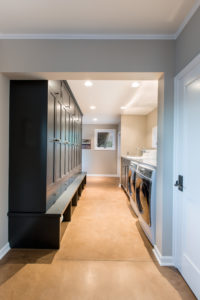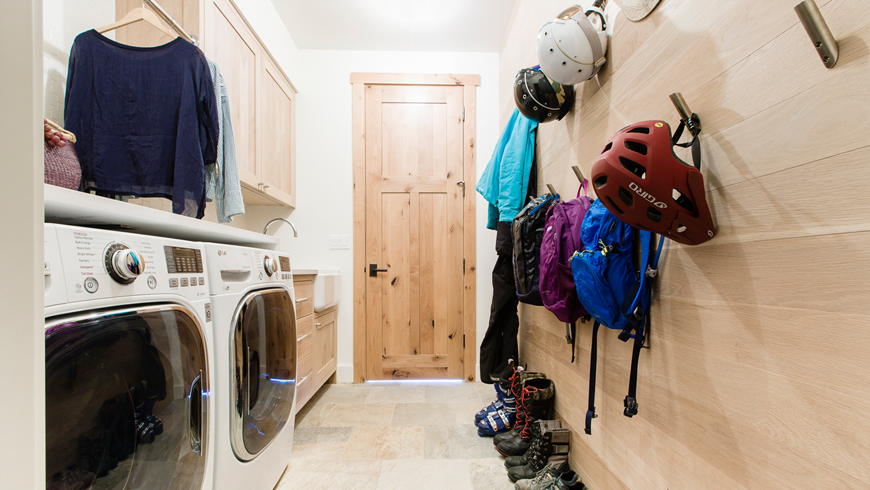The term “mudroom” conjures up images of that room—typically off the garage—where things without a place or home seemingly go to live. Keys, dirty boots, jackets, backpacks, dog leashes, and any number of objects are often thrown into this “transition” area. Since it’s often the first room entered when coming in from the garage or the outside, it’s easy to become the home for all of these cast-off items. Even the name—mudroom—seems to imply that this room will never be more than a mess.
But no longer. As more money and time is spent on the design of one’s home, the mudroom is being just as meticulously, if not more, curated as the rest of the house. From Southern Living to Houzz.com to The Boston Globe, design resources are touting the reformation and trendiness of the new mudroom. The use, design, and materials of an individual mudroom have undergone a transformation creating a new area of the home with both purpose and beauty.
Common uses for mudrooms are laundry; storage of coats, boots, and jackets; and often sports equipment. These uses still apply but are being taken even further in their design.
Susan Witman, owner of Susan Witman Interior Design, suggested, “In addition to a washer, dryer, and sink it’s nice to have hamper space, an area for air-drying clothing, an ironing board, and a folding countertop area.” New uses for the area might include a dedicated dog washing station; a bullet or corkboard for activities, events, and concert tickets; recycling; an area for charging stations for phones; or simply overflow from the kitchen and pantry. Witman added, “Some of my clients have created additional cleanup for parties since the kitchen is often located in the living area while the entertaining is going on. This includes a dishwasher along with a sink with a spray faucet and garbage disposal.”
In designing mudrooms for the clientele of Sun Valley, it’s important for a mudroom to have both form and function. “I have designed a fair share of mudrooms throughout the years,” explained Allison Connolly, owner of Allison Paige Interior Design. “I have noticed lately that my clients are open to taking the design of these spaces up a notch. It’s no longer just about durability and cleanability; with an eye on polish, clients are giving me license to thoroughly plan these spaces for functionality and practicality.”
In the climate of Sun Valley where the seasons bring any combination of mud, dirt, snow, and rain, it’s especially important for there to be a place for every season’s jackets, sports uniforms, shoes, and gear.
Jennifer Hoey, owner of Jennifer Hoey Interior Design offered, “In designing mudrooms for mountain living—depending on the space—I try to give flexibility based upon sports and seasons that the clients are using the home. Our clients rely on us to provide expertise in this area as they are often building second homes and aren’t sure how to use the space in our climate.” Hoey recommended providing boot drying systems for those avid skiers or snowboarders, in addition to cubbies, open-, and closed-door storage. “Open storage with hooks and cubbies are good for quick day-to-day ease. We often outfit open cubbies with baskets to hold small items like hats, sunglasses, and gloves. Closed-door storage is great for off-season coats and boots where you have easy access when the weather changes.”
If space allows, family members might want individual storage areas for their gear and season-to-season clothing. Mike Brunelle of Brunelle Architects, explained, “Recently, we have had clients with very active lifestyles and have been inspired by their pursuits. For them, the mudroom needs to be a space to get them fired up for the day’s adventure—complete with views, great light, and open shelves and hooks to ‘display’ the gear they love to use. For others not so inspired, everything behind cabinet doors.” Connolly added, “I like to be sure that the mudroom works for the family using it and plan for appropriate storage in terms of scale and quantity.”
When it comes to the use of materials in the mudroom, the finishes might be just as high-end as anywhere else in the home. But it’s important that in addition to being good-looking, the materials used are both practical and durable to withstand the elements being brought in: mud, dirt, snow, and grass. “I always use stone or durable floor so muddy or snowy shoes can dry easily without special effort,” said Hoey. Make sure whatever materials you pick are also easy to clean.
In addition to practical materials, there are also some fun options to choose such as chalkboard paint, which allows children to draw on the walls or label their coat hook. A wall made of corkboard also allows for any number of items to be tacked up and adds to the creativity of the room. In short, there is no end of possibilities. “We are not stopping short on finishes,” explained Connolly. “Think custom cabinetry, high-end tile, and hardware.”
Whether you are embarking on building your own home or are simply inspired to revamp your current mudroom, take time to think through what aspects of this room are truly important to you, then follow-up with materials and storage that make this space a saving grace to your house rather than a source of anxiety. Here’s to the new and improved mudroom!


